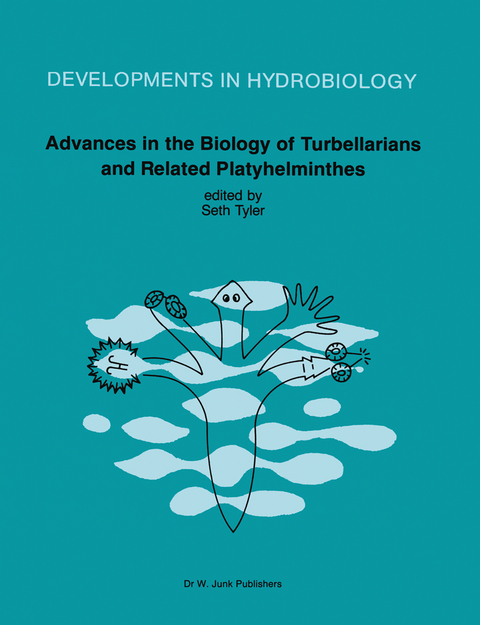
Advances in the Biology of Turbellarians and Related Platyhelminthes
Kluwer Academic Publishers (Verlag)
978-90-6193-542-1 (ISBN)
While the reality of the taxon Turbellaria has been called into question lately, turbellarians are nevertheless the subject of active research by a sizable group of biologists. Turbellarians are relatives of the major groups of parasitic platyhelminthes - monogeneans, digeneans, and tapeworms - and most are free-living. Because the ancestors to the major parasitic groups would be classified as turbellarians, strict application of princi- ples of phylogenetic systematics dictates that the Turbellaria is not properly considered a separate taxon; i. e. , it is, in the parlance of systematics, a paraphyletic group. The relationships of turbellarians to other inver- tebrates are even more problematic than their relationships to other platyhelminthes; their relatively simple morphology has been variously interpreted as quintessentially primitive - meaning a turbellarian-like ances- tor would have given rise to most of the major groups of invertebrates - or as secondary simplification, meaning they would essentially be a dead-end group. Modern research on turbellarians covers a broad spectrum.
Questions of phylogenetics have inspired ultrastructural studies; the simply structured nervous systems of turbellarians make them good subjects for neurophysiology; simplicity of their tissue structure and the limited number of cell types make them good subjects of embryological and regeneration studies; they are emerging as iIIJ. portant indicator species in ecolo- gy; and improvements in biochemical methodology have meant they are at last amenable - despite their small size - to molecular biological study.
Phylogeny.- Comments on a phylogenetic system of the Platyhelminthes.- Is the Turbellaria polyphyletic?.- The major parasitic platyhelminth classes — progressive or regressive evolution?.- Initial morphological diversity as a criterion in deciphering turbellarian phylogeny.- Asexual reproduction and the turbellarian archetype.- Ultrastructure of the frontal organ in Convoluta and Macrostomum spp.: significance for models of the turbellarian archetype.- The phylogenetic significance of sperm morphology in the Platyhelminthes.- Phylogenetic relationships of the Temnocephaloidea (Platyhelminthes).- An ultrastuctural and cytochemical study of the digestive system in Oxyposthia praedator (Turbellaria: Acoela).- Frontal organs in the Acoelomorpha (Turbellaria): ultrastructure and phylogenetic significance.- Nervous System and Sensory Structures.- On the evolution of central nervous systems: implications from polyclad turbellarian neurobiology.- Comparative characterization of the nervous system of the Turbellaria.- Neuropeptides in free-living and parasitic flatworms (Platyhelminthes). An immunocytochemical study.- Aspects of photoreceptor structure and phototactic behavior in Platyhelminthes, with particular reference to the symbiotic turbellarian Paravortex.- Ontogeny.- Embryology of the Turbellaria and its phylogenetic significance.- Experimental evidence for the origins of determinative development in the polyclad turbellarians.- Electron microscopic study of larval eye development in Turbellaria Polycladida.- Reproductive System.- Eggshell formation in polyclads (Turbellaria).- Fine-structural characters in female and male germ cells of Proseriata Otoplanidae (Platyhelminthes).- Ultrastructural features of oogenesis in some marine neoophoran turbellarians.-Ultrastructural investigations on the differentiation of genital hard structures in free-living platy- helminths and their phylogenetic significance.- Ultrastructure of the copulatory stylet and accessory spines in Haplopharynx quadristimulus (Turbellaria)..- Comparative ultrastructure of copulatory organs having a stylet in the Proseriata (Turbellaria).- Development of the reproductive apparatus of the land planarian Rhynchodemus sylvaticus (Turbellaria: Tricladida) and its significance for classification in the genus.- Regeneration.- Cell migration and differentiation during wound healing and regeneration in Microstomum lineare (Turbellaria).- Physiological regeneration of the digestive parenchyma in Convoluta convoluta and Oxyposthia praedator (Turbellaria, Acoela).- Asexual reproduction, regeneration, and somatic embryogenesis in the planarian Dugesia tigrina (Turbellaria).- Positional information and gonadal differentiation in the planarian Dugesia lugubris (Turbellaria).- On the origins of neoblasts in freshwater planarians (Turbellaria).- Ultrastructural observations on gastrodermal regeneration in the planarian Dugesia japonica (Turbellaria).- Protein phosphorylation and the role of Ca2+ in planarian turbellarian regeneration.- Biology of long slender land planarians (Turbellaria) in Tokyo and environs.- Systematics and Cytology.- Karyology of a marine population of Gyratrix hermaphroditus (Turbellaria, Rhabdocoela) and chromosomal evolution in this species complex.- Chromosomal evolution in marine triclads and polyclads (Turbellaria).- Variation in karyotypes of Dugesia japonica japonica (Turbellaria) from Ôsaka Prefecture, central Japan.- On the karyology of Dugesia gonocephala s.l. (Turbellaria, Tricladida) from Montpellier, France.- Taxonomic studies onmarine triclads (Turbellaria, Tricladida, Maricola).- Ecology.- Ontogenetic patterns and phylogenetic trends in freshwater flatworms (Tricladida); constraint or selection?.- Reproductive ecology of Dendrocoelum lacteum (Turbellaria) in a rapid stream in southern Sweden and comparisons with a lake population.- Salinity-temperature tolerance of two closely related triclad species, Dugesia lugubris and D. polychroa (Turbellaria), in relation to their distribution in The Netherlands.- Distribution, abundance, and size of rhabdoids in Dugesia polychroa (Turbellaria: Tricladida).- The importance of turbellarians in the marine meiobenthos: a review.- Symbiotic Relationships.- An overview of surface specializations in the digenetic trematodes.- Occurrence of symbiotic turbellarians in the oyster Crassostrea virginica.- History.- History of the study of Turbellaria in China. Part 1: Ages of Materia Medica and of early expeditions by westerners.- Electron microscopy of turbellarian platyhelminths — a bibliography.- Index to authors.- Index to subjects.
| Erscheint lt. Verlag | 28.2.1986 |
|---|---|
| Reihe/Serie | Developments in Hydrobiology ; 32 |
| Zusatzinfo | 130 Illustrations, black and white; XVIII, 358 p. 130 illus. |
| Verlagsort | Dordrecht |
| Sprache | englisch |
| Maße | 216 x 280 mm |
| Themenwelt | Naturwissenschaften ► Biologie ► Limnologie / Meeresbiologie |
| Naturwissenschaften ► Biologie ► Ökologie / Naturschutz | |
| ISBN-10 | 90-6193-542-3 / 9061935423 |
| ISBN-13 | 978-90-6193-542-1 / 9789061935421 |
| Zustand | Neuware |
| Haben Sie eine Frage zum Produkt? |
aus dem Bereich


